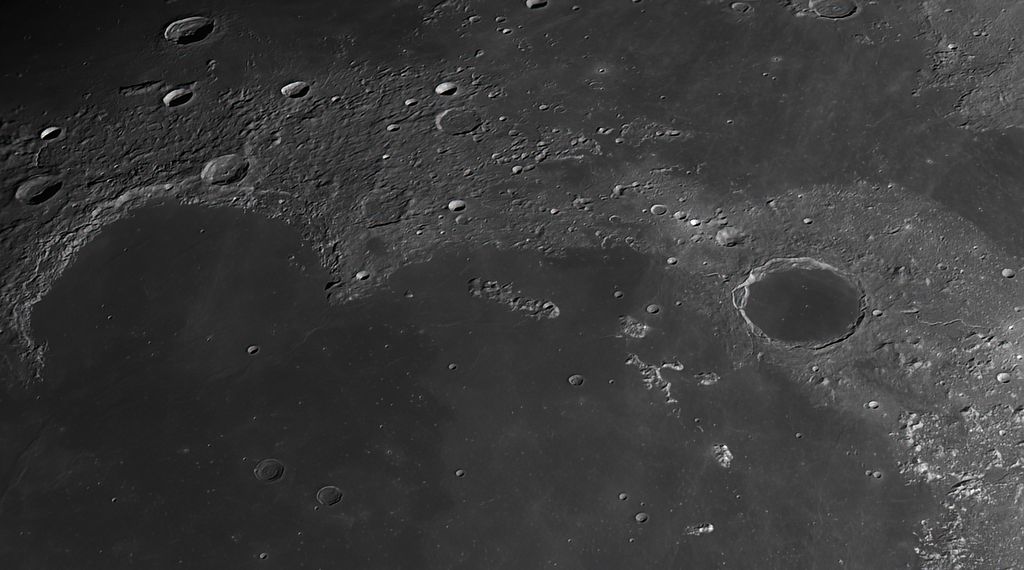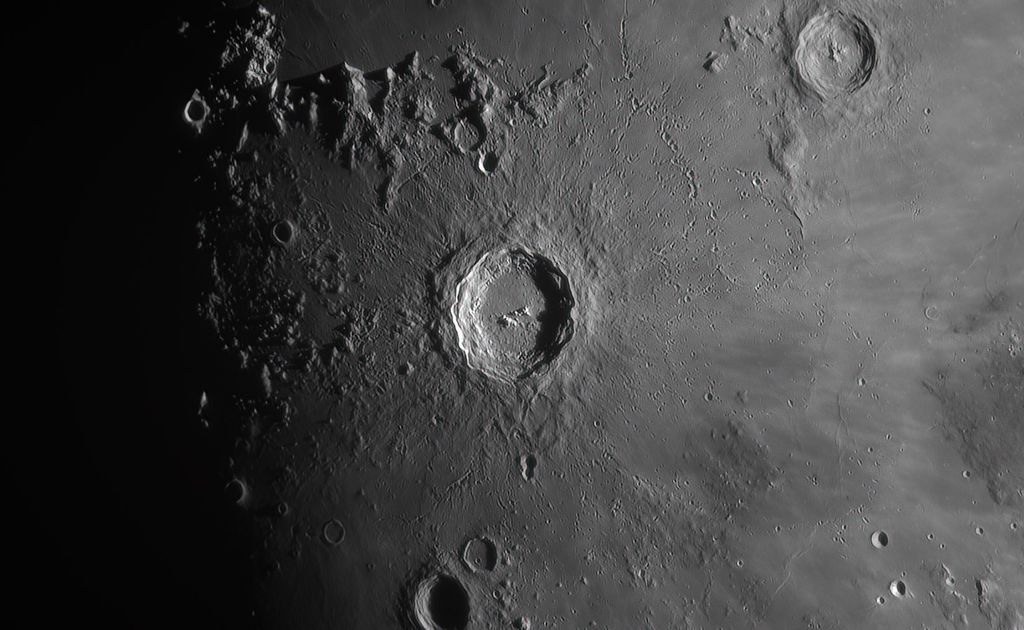Forgive the noob question, but I am a noob with lunar!
I've only been doing lunar for a couple of weeks and I am aware that I need to keep exposures relatively short to 'freeze' atmospheric seeing as much as possible (so I am generally using 1-5ms), but since the moon doesn't rotate I can't see that frame rate would matter, would it? Obviously a lower frame rate has the disadvantage that it takes longer to collect enough frames, but presumably it doesn't affect the actual image?
I understand why high frame rate is desirable on planets, as they rotate quite fast. But not on the moon, I am guessing?
Thanks
|
You cannot like this item. Reason: "ANONYMOUS".
You cannot remove your like from this item.
Editing a post is only allowed within 24 hours after creating it.
You cannot Like this post because the topic is closed.
|
The Moon does actually move about somewhat, the movement is called libration but they are quite slow as they occur over one lunar month. For really high resolution lunar imagery there is another factor to keep in mind which is the variation of illumination with time, which might be critical depending where you are pointing at. But in general the length of time requirements are pretty lax for lunar imagery. That has NOTHING to do with the exposure lenght of single frame (or otherwise known as frame rate) which is heavily dependant on seeing and SNR. So this requirement is just the same for planets as it is for Luna.
|
You cannot like this item. Reason: "ANONYMOUS".
You cannot remove your like from this item.
Editing a post is only allowed within 24 hours after creating it.
You cannot Like this post because the topic is closed.
andrea tasselli:
exposure lenght of single frame (or otherwise known as frame rate)
The exposure length of a single frame is not the same as the frame rate.
For example, I am capturing moon images usually with an exposure time of 1 - 5 ms, but my frame rate is only about 7fps (as it's a large sensor).
I understand that the exposure length is important (keep it short), but my question is does the frame rate matter?
|
You cannot like this item. Reason: "ANONYMOUS".
You cannot remove your like from this item.
Editing a post is only allowed within 24 hours after creating it.
You cannot Like this post because the topic is closed.
|
In my time the two were pretty much one and the same but, yes, you're right they are NOT the same in general. To answer your question; it is the same as to say how long can I capture a given body before rotation gets in the way. The answer was in my previous replay to your question and in short it is: it depends, but in general you are allowed around 10 minutes as a rule of thumb. More or less depends on circumstances.
|
You cannot like this item. Reason: "ANONYMOUS".
You cannot remove your like from this item.
Editing a post is only allowed within 24 hours after creating it.
You cannot Like this post because the topic is closed.
andrea tasselli:
In my time the two were pretty much one and the same but, yes, you're right they are NOT the same in general. To answer your question; it is the same as to say how long can I capture a given body before rotation gets in the way. The answer was in my previous replay to your question and in short it is: it depends, but in general you are allowed around 10 minutes as a rule of thumb. More or less depends on circumstances.
Thanks. This is helpful. I shall try and keep my videos down to < 10min then.
|
You cannot like this item. Reason: "ANONYMOUS".
You cannot remove your like from this item.
Editing a post is only allowed within 24 hours after creating it.
You cannot Like this post because the topic is closed.
Hello Stuart,
Here is a general idea what I shoot for the moon when image it.
1st I do not take individual images, I uses the Ser video format.
2nd I’m using the 290mm camera from ZWO and at full frame size/resolution I almost always get 82-84 frames per second.
I personally use a sequence of video’s. My sequence is usually 3 - 45sec video’s then I process them in AutoStackert 3 load all the images I decide in Registax, stack and use the wavelets for sharpening the image. Once I’m happy with it I then will take the image in Gimp and tweak the contrast, brightness etc…
When I take the sequence I’ll generally shoot it so that its a tad on the dark side and do the brightness tweaks “post processing” in Gimp.
Just another note I use the Pro-Planet UV/IR cut 642nm filter which helps somewhat with cutting some of the turbulence in the atmosphere.
Dale
|
You cannot like this item. Reason: "ANONYMOUS".
You cannot remove your like from this item.
Editing a post is only allowed within 24 hours after creating it.
You cannot Like this post because the topic is closed.
I'm not sure the moon needs videos. It is so bright that you can capture a burst of well exposed still images (typically 1/640 secs) that can be stacked. Here's one of my attempts:

Moon -- quick stitch of 30 shots on Sony NEX 5N through Skywatcher 200 PDS |
You cannot like this item. Reason: "ANONYMOUS".
You cannot remove your like from this item.
Editing a post is only allowed within 24 hours after creating it.
You cannot Like this post because the topic is closed.
The moon despite being one of the darkest large planetary body out there does well at prime focus. High resolution imagery is another matter entirely so, yes, it needs video. Such as to get the rille running along Vallis Alpes:
 |
You cannot like this item. Reason: "ANONYMOUS".
You cannot remove your like from this item.
Editing a post is only allowed within 24 hours after creating it.
You cannot Like this post because the topic is closed.
Andy Wray:
I'm not sure the moon needs videos. It is so bright that you can capture a burst of well exposed still images (typically 1/640 secs) that can be stacked. Here's one of my attempts:

Moon -- quick stitch of 30 shots on Sony NEX 5N through Skywatcher 200 PDS
Andy I didn’t say that you can’t do it in that manner, I stated that “most” use video to help eliminate atmospheric seeing. While that shot is more of a portrait its isn’t high resolution as @andrea tasselli had mentioned. Video really is the best way to get high resolution images of the planets and lunar surfaces.
Dale
   |
You cannot like this item. Reason: "ANONYMOUS".
You cannot remove your like from this item.
Editing a post is only allowed within 24 hours after creating it.
You cannot Like this post because the topic is closed.
Dale Penkala:
Hello Stuart,
Here is a general idea what I shoot for the moon when image it.
1st I do not take individual images, I uses the Ser video format.
2nd I’m using the 290mm camera from ZWO and at full frame size/resolution I almost always get 82-84 frames per second.
I personally use a sequence of video’s. My sequence is usually 3 - 45sec video’s then I process them in AutoStackert 3 load all the images I decide in Registax, stack and use the wavelets for sharpening the image. Once I’m happy with it I then will take the image in Gimp and tweak the contrast, brightness etc…
When I take the sequence I’ll generally shoot it so that its a tad on the dark side and do the brightness tweaks “post processing” in Gimp.
Just another note I use the Pro-Planet UV/IR pass 642nm filter which helps somewhat with cutting some of the turbulence in the atmosphere.
Dale
Thank you for this Dale. Those are some really super images! Well done!
|
You cannot like this item. Reason: "ANONYMOUS".
You cannot remove your like from this item.
Editing a post is only allowed within 24 hours after creating it.
You cannot Like this post because the topic is closed.
Stuart Taylor:
Dale Penkala:
Hello Stuart,
Here is a general idea what I shoot for the moon when image it.
1st I do not take individual images, I uses the Ser video format.
2nd I’m using the 290mm camera from ZWO and at full frame size/resolution I almost always get 82-84 frames per second.
I personally use a sequence of video’s. My sequence is usually 3 - 45sec video’s then I process them in AutoStackert 3 load all the images I decide in Registax, stack and use the wavelets for sharpening the image. Once I’m happy with it I then will take the image in Gimp and tweak the contrast, brightness etc…
When I take the sequence I’ll generally shoot it so that its a tad on the dark side and do the brightness tweaks “post processing” in Gimp.
Just another note I use the Pro-Planet UV/IR pass 642nm filter which helps somewhat with cutting some of the turbulence in the atmosphere.
Dale
Thank you for this Dale. Those are some really super images! Well done!
No problem Stuart, and thanks.
Dale
|
You cannot like this item. Reason: "ANONYMOUS".
You cannot remove your like from this item.
Editing a post is only allowed within 24 hours after creating it.
You cannot Like this post because the topic is closed.
to create to post a reply.








